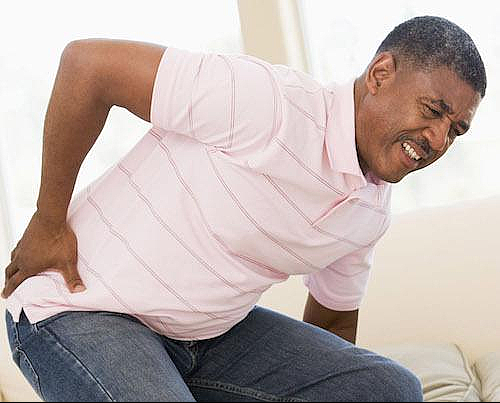Back pain is one of the primary disabling health conditions among older adults aged 60 years and older. As a matter of fact, about 80 percent of adults experience low back pain at some point in their lifetime. Several studies of patients with low back pain found that African Americans reported greater pain and higher levels of disability than whites. Over time, the day-to-day use of our backs can cause discomfort, but there are also other contributors such as obesity, smoking, ethnicity, poor nutrition, and other health conditions. However, aging is still the number one cause of back pain, and menopausal women especially experience tend to experience lower back pain more than any other group.
What brings on back pain?
Back pain is more common in folks who are not active. If you’re sedentary most of the time and then exert yourself now and then, you’re at risk for a back injury. If you’re carrying extra weight, particularly around the belly, you’re taxing your spine. Ethnicity can also be blamed for back pain; Black women are two to three times more likely than their white counterparts to develop spondylolisthesis, a condition in which a bone—vertebra—of the lower spine slips out of place. Having a job that demands a lot of heavy lifting like landscaping or sanitation work can place you at risk for a back injury. Poor posture like hunching over your computer or just standing for long periods, long-distance driving, sneezing/coughing hard, and a bad mattress can give you the back pain blues.
If you think puffing on a cigarette can’t possibly injure your back, then you’re wrong! The nasty little habit will not directly cause an injury, but it places you at risk for sciatica, a condition where radiating pain along the sciatic nerve runs down one or both legs from the lower back. Smoking can actually block the body’s ability to deliver nutrients to the lower back discs.
Back pain can also be inherited. According to a large study done in 2011, researchers discovered that people with an immediate family member, such as a parent, sibling, or child, with disc-related low back pain, were more than four times more likely to have low-back pain. Interestingly enough, there were even increases in risk associated with having a second-degree (grandparents, aunts, uncles) or even a third-degree relative (first cousin) diagnosed with herniated or degenerative disc disease.
Other issues like sprains, strains, or injuries, can result in back discomfort. Structural problems like arthritis, spinal stenosis (narrowing of the spaces within your spine), bulging discs (pressure on spinal nerves), osteoporosis (weak/brittle bones), herniated disc (soft inner gel in the disc that leaks back into the spinal canal), all these and more can also bring on serious back pain.
How do you spell r-e-l-i-ef?
There are many treatment options for back pain, and the prescription depends on its severity. A healthcare provider will examine you and, based on their findings, will determine if your particular back issue will best benefit from physical therapy, pain medication, or in some cases, surgery.
Can back pain be prevented?
Usually, people who live healthy lifestyles age better, according to medical experts. If you want to help stave off back issues as you age, try incorporating these recommendations into your daily lifestyle:
- Exercise proper posture when you sit or stand
- Eat a nutritious diet
- Watch your weight
- Don’t smoke
- Hit the gym and concentrate on exercises that strengthen your core
- Don’t stress your back by lifting heavy objects, or bending/standing for too long
